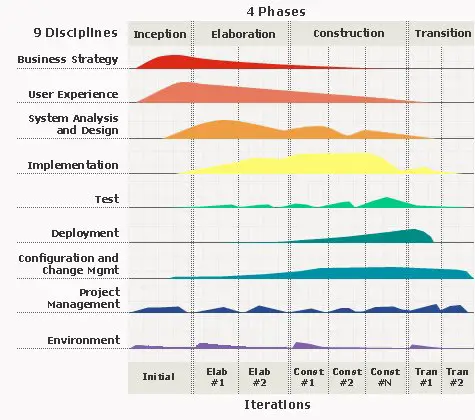|
Subsections
The Rational Unified Process formally consists of the following steps:
- Inception - a discover phase, where an initial problem statement and functional requirements are created.
- Elaboration - the product vision and architecture are defined, construction cycles are planned.
- Construction - the software is taken from an architectural baseline to the point where it is ready to make the transition to the user community.
- Transition - The software is turned into the hands of the user's community.
Figure 1.9:
A high-level view of the Rational Unified Process. (Image courtesy of Rational Software.)
|
|
The ``The Rational Unified Process, An Introduction''[9] specifies the following objectives, activities, and artifacts from an inception phase.
- Establish project's scope and boundary conditions.
- Determine the critical uses of the system.
- Exhibiting at least one candidate architecture against some of the primary scenarios.
- Estimating the overall cost and schedule for the entire project.
- Estimating potential risks.
- Formulate the scope of the project.
- Plan and prepare the business case, including alternatives for risk management, staffing, project plan, and trade-offs between cost, schedule, and profitability.
- Develop a candidate architecture.
- A vision document.
- A use-case model survey.
- An initial project glossary.
- An initial business case.
- An initial risk assessment.
- A project plan.
- Other possible items:
- An initial use-case model.
- An initial domain model.
- One or more prototypes.
The ``The Rational Unified Process, An Introduction''[9], specifies the following purpose, objectives, activities, and outcome from an elaboration phase.
- Analyze the problem domain.
- Establish a sound architecturla foundation.
- Develop the project plan.
- Eliminate the highest-risk elements.
- Define, validate, and baseline the architecture.
- Baseline the vision.
- Baseline a plan for the construction phase.
- Demonstrate that the baseline architecture will support the vision for a reasonable cost in a reasonable time, or not.
- The vision is elaborated.
- The process, infrastructure, and development environment are elaborated.
- Processes, tools, and automation support are put into place.
- The architecture is elaborated and the components are selected.
- An 80% complete use-case model has been developed.
- Supplementary requirements are documented.
- A software architecture description is created.
- An executable architectural prototype is created.
- A revised risk list and business case are created.
- A development plan for the overall project is created.
- An updated development case is created, specifying the process to be used.
- Construction plan.
- Software prototypes.
- Risk identification and management plan.
- A test plan.
- A data dictionary.
- A preliminary user manual.
The ``The Rational Unified Process, An Introduction''[9], specifies the following objectives, activities, and deliverables from a construction phase.
- Minimize development costs by optimizing resources and avoiding unnecessary scrap and rework.
- Achieving adequate quality as rapidly as practical.
- Achieving useful versions as rapidly as practical.
- Resource management, resource control, process optimization.
- Complete component development and testing.
- Assessment of product releases against acceptance criteria.
- The software product integrated on the adequate platforms.
- User manuals.
- A description of the current release.
The text ``The Rational Unified Process, An Introduction''[9], specifies the following purpose, objectives and activities from a transition phase.
- Transition the software to the user community.
- Beta testing.
- Parallel operation with any existing legacy system.
- Conversions of operational databases.
- Training of users.
- Product rollout.
- Achieving user self-supportability.
- Achieving stakeholder buy-in that the deployed product is complete and consistent with the evaluation criteria of the vision.
- Achieving final product baseline as rapidly and cost-effectively as possible.
- Deployment-specific engineering:
- Cutover
- Commercial packaging and production
- Sales rollout
- Field personnel training
- Tuning activities, bug-fixing, and enhancement for performance and usability.
- Assessing the deployment baseline against the vision and acceptance criteria.
|
|




